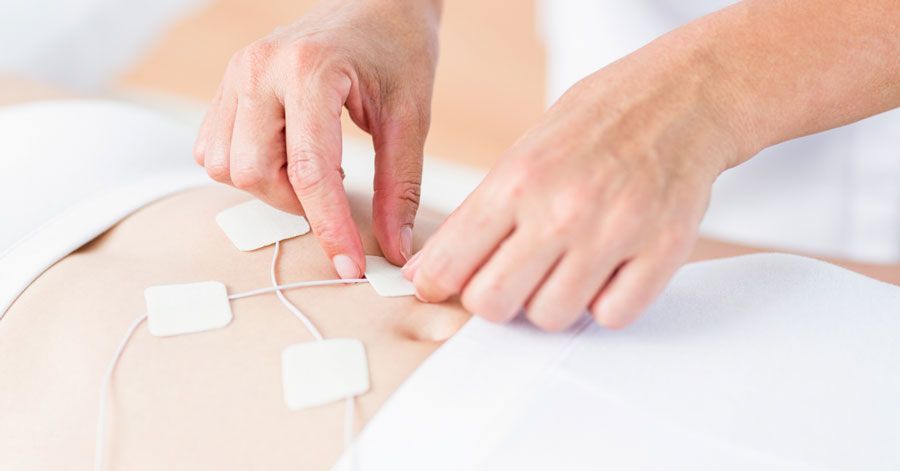Electrical current is a flow of charged particles, known as electrons or ions. Electrical currents have been innovatively applied to biological systems to alter physiological processes since 46 CE. Historical records detail an electrical discharge from a torpedo fish being used to alleviate pain.
Electrotherapy means, “the therapeutic use of electric currents via a machine,” and has a wide range of clinical applications in the treatment of injury which include controlling pain and promoting tissue healing.
There are many types of electrotherapy devices used to deliver a current of different waveforms transcutaneously for therapeutic purposes, they typically consist of controls to tune the output current, a power source and sockets to connect the electrode leads. Technological advancement has provided electrotherapy devices that come in portable form, powered by a 9-volt battery, about the size of a smartphone. Larger electrotherapy devices, which are about the size of a shoe box usually need to be plugged into the wall (110 – 240 volt AC), some even have rechargeable batteries allowing them to run for a few hours when not plugged in. The leads connect the device to electrodes that are placed on the patient’s skin to deliver the current. The electrical current then flows through these electrodes into the patient, targeting their underlying tissues.
Pain control is one of the most notable benefits of electrotherapy. Electrotherapy can cause a reduction of pain sensation in an injury through a process called gate control. Gate control theory was initially proposed by Melzack and Wall, who put forward that electrical current delivered to the treatment area may reduce the sensation of pain by interfering with pain signal transmission at the spinal cord level. Electrical current stimulation during treatment can block nociceptors, which inhibits the transmission of nociceptive signals through the spinal cord by closing the gate so that no transmission of painful stimuli is allowed to pass from the spinal cord to the brain.
When electrotherapy is performed on a patient, it has the additional benefit of promoting the release of Dopamine which acts as a neuromodulator, effective in controlling pain. The application of electrical current prompts the production and release of endorphins and enkephalins, these substances are known as endogenous opioids, they act similarly to morphine and are good for modulating pain perception by binding to opiate receptors in the brain. Studies have shown that electrotherapy is beneficial in reducing both acute and chronic pain when it’s applied together with exercises by providing an analgesic effect, reducing postoperative pain after surgery meanwhile displaying very few adverse effects. Before electrotherapy is carried out, a careful evaluation of the patient’s medical history and current medical status is examined to identify any contraindications. Due to the fact that electrotherapy does not rely on drugs or other pharmaceuticals, it can be characterised as a low-risk therapy.
In rehabilitation, electrotherapy has also been useful by increasing circulation to the tissue or used as an oedema management method. Oedema often coincides with a decrease in function, an increase in pain and prolonged recovery times. Delivery of electrical stimulation to the affected area can potentially reduce inflammation associated with oedema and reduce recovery times due to acute injuries such as joint sprains and strains.
Bioelectric Meridian Therapy (BMT) is an advanced form of electrotherapy, combining aspects of TCM meridian theory and the latest technology. It utilises the ABMMA PRO BMT Device, which has been approved by the Australian Therapeutic Goods Administration.
Nelson
BMT practitioner
Reference
Cambridge NA. Electrical apparatus used in medicine before 1900. Proc R Soc Med. 1977;70:635–641.
Melzack R, Wall PD. Pain mechanisms: a new theory. Science. 1965;150:971–979.
Wall PD. The gate control theory of pain mechanisms: a re-examination and restatement. Brain. 1978;101:1–18.
Sabino GS, Santos CM, Francischi JN, et al. Release of endogenous opioids following transcutaneous electric nerve stimulation in an experimental model of acute inflammatory
pain. J Pain. 2008;9:157–163.
Sjolund BH, Terenius L, Eriksson M. Increased cerebrospinal fluid levels of endorphins after electroacupuncture. Acta Physiol Scand. 1977;100:382–384.
Sjolund BH, Terenius L, Eriksson M. Increased cerebrospinal fluid levels of endorphins after electroacupuncture. Acta Physiol Scand. 1977;100:382–384.
Petrofsky J, Schwab E, Lo T, et al. Effects of electrical stimulation on skin blood flow in controls and in and around stage III and IV wounds in hairy and nonhairy skin. Med Sci Monit. 2005;11:CR309–CR316.
Mendel FC, Wylegala JA, Fish DR. Influence of high voltage pulsed current on edema formation following impact injury in rats. Phys Ther. 1992;72:668–673.


